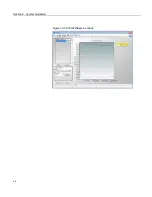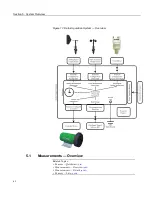
Section 5. System Overview
5.1.8 Cabling Effects — Overview
Related Topics:
•
Cabling Effects — Overview
(p. 74)
•
Cabling Effects — Details
(p. 364)
Sensor cabling can have significant effects on sensor response and accuracy. This
is usually only a concern with sensors acquired from manufacturers other than
Campbell Scientific. Campbell Scientific sensors are engineered for optimal
performance with factory-installed cables.
5.1.9 Synchronizing Measurements — Overview
Related Topics:
•
Synchronizing Measurements — Overview
(p. 74)
•
Synchronizing Measurements — Details
(p. 365)
Timing of a measurement is usually controlled relative to the CR1000 clock.
When sensors in a sensor network are measured by a single CR1000,
measurement times are synchronized, often within a few milliseconds, depending
on sensor number and measurement type. Large numbers of sensors, cable length
restrictions, or long distances between measurement sites may require use of
multiple CR1000s.
5.2
PLC Control — Overview
Related Topics:
•
PLC Control — Overview
(p. 74)
•
PLC Control — Details
(p. 244)
•
PLC Control Modules — Overview
(p. 368)
•
PLC Control Modules — Lists
(p. 648)
•
PLC Control — Instructions
(p. 562)
• Switched Voltage Output
— Specifications
•
Switched Voltage Output — Overview
(p. 78)
•
Switched Voltage Output — Details
(p. 103)
This section is slated for expansion. Below are a few tips.
•
Short Cut programming wizard has provisions for simple on/off control.
•
PID control can be done with the CR1000. Ask a Campbell Scientific
application engineer for more information.
•
When controlling a PID algorithm, a delay between processing (algorithm
input) and the control (algorithm output) is not usually desirable. A delay
will not occur in either
sequential mode
(p. 527)
or
pipeline mode
(p. 523),
assuming an appropriately fast scan interval is programmed, and the program
is not skipping scans. In sequential mode, if some task occurs that pushes
processing time outside the scan interval, skipped scans will occur and the
PID control may fail. In pipeline mode, with an appropriately sized scan
buffer, no skipped scans will occur. However, the PID control may fail as the
processing instructions work through the scan buffer.
•
To avoid these potential problems, bracket the processing instructions in the
CRBasic program with
ProcHiPri
and
EndProcHiPri
. Processing
74
Summary of Contents for CR1000
Page 2: ......
Page 4: ......
Page 6: ......
Page 32: ......
Page 36: ......
Page 38: ......
Page 40: ......
Page 60: ...Section 4 System Quickstart Figure 16 PC200W View Line Graph 60 ...
Page 96: ......
Page 98: ...98 ...
Page 302: ......
Page 453: ...Section 8 Operation Figure 115 Using the Keyboard Display 453 ...
Page 456: ...Section 8 Operation Figure 118 Real Time Custom 456 ...
Page 457: ...Section 8 Operation 8 8 1 3 Final Memory Tables Figure 119 Final Memory Tables 457 ...
Page 458: ...Section 8 Operation 8 8 2 Run Stop Program Figure 120 Run Stop Program 458 ...
Page 460: ...Section 8 Operation Figure 122 File Edit 460 ...
Page 461: ...Section 8 Operation 8 8 4 PCCard Memory Card Display Figure 123 PCCard CF Card Display 461 ...
Page 478: ......
Page 506: ......
Page 536: ......
Page 636: ......
Page 642: ......
Page 644: ......
Page 676: ......
Page 677: ......
















































